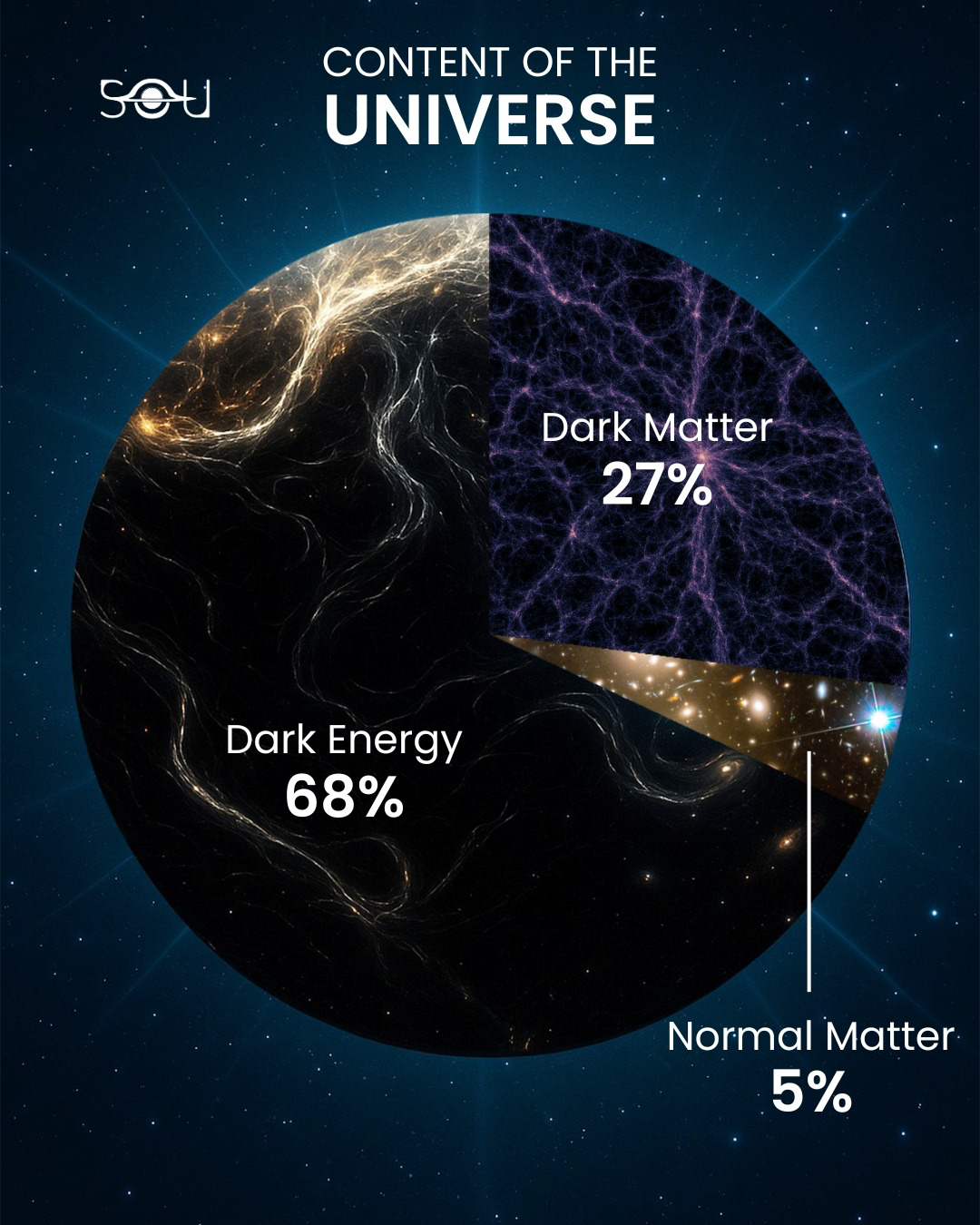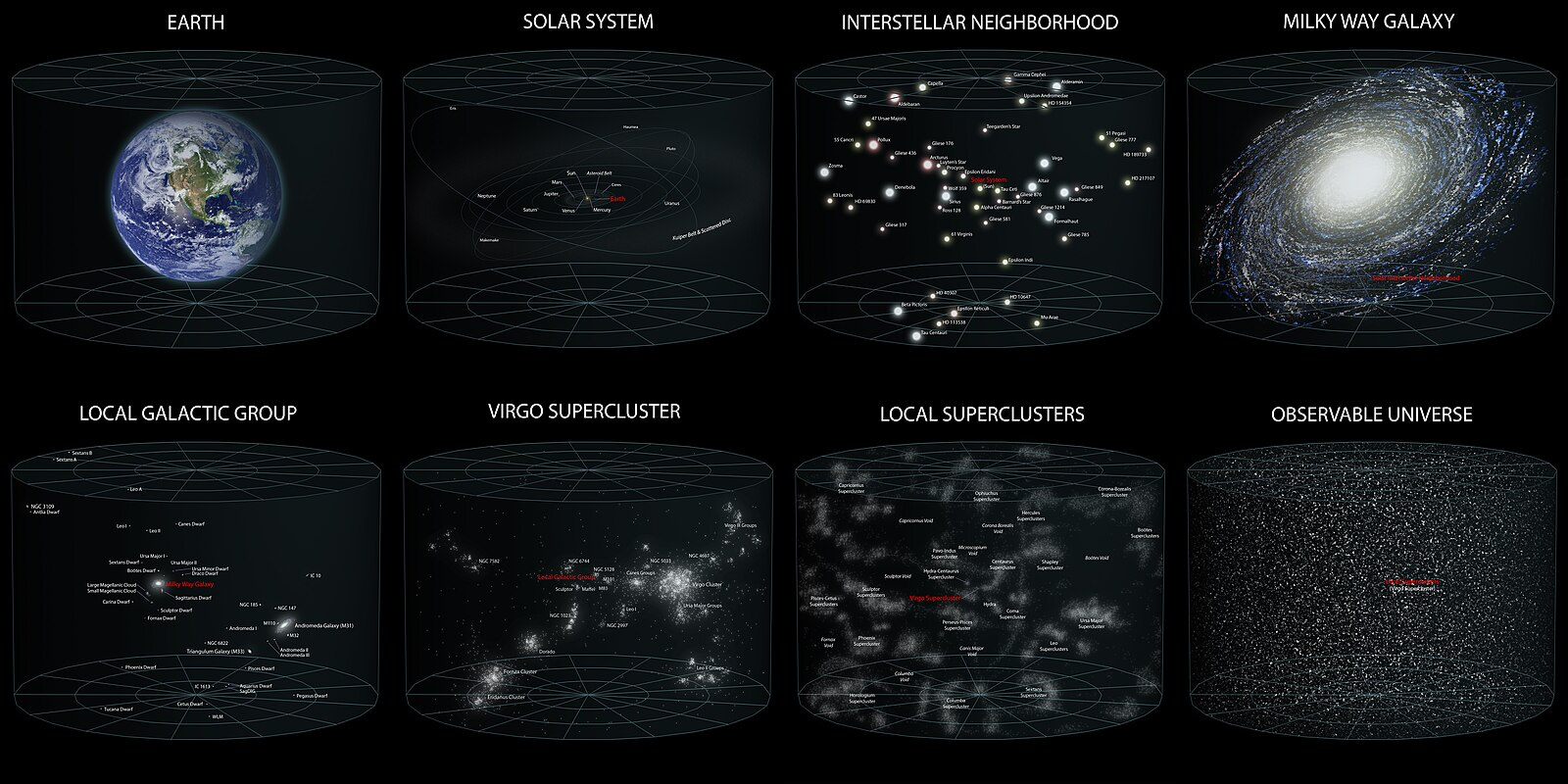The Large-Scale Universe
Modern cosmology tells us that the universe began about 13.8 billion years ago in the event we call the Big Bang. This was not an explosion in empty space but the expansion of space itself, carrying galaxies with it. In the first tiny fraction of a second, the universe inflated at unimaginable speed. As it expanded, it cooled, allowing matter to form: first subatomic particles, then atoms, mainly hydrogen and helium.
Gravity drew this gas together into clouds that collapsed to form the first stars and galaxies. Stars forged heavier elements in their fiery cores, then spread them into space when they died. Everything we are, our bodies, our planet, the air we breathe, is made of stardust.

The Universe Through Time: A visual journey from the Big Bang to the present day, showing how the cosmos evolved from the first light, to galaxies and stars, and finally to the universe we observe today. (Source: Stargazing Live)
We know this story because of evidence left behind. A faint glow, the Cosmic Microwave Background, is the “afterglow” of the Big Bang. The fact that distant galaxies are all moving away from us shows that the universe is still expanding. And the abundance of light elements matches predictions of Big Bang theory. The Big Bang was not an explosion of stuff in one place; it was space itself expanding everywhere at once. The universe has no centre, every point is part of the expansion.
But there are deeper mysteries. Astronomers discovered that most of the universe is invisible. Dark matter, an unseen form of mass, holds galaxies together. Dark energy, a mysterious force, pushes the universe to expand faster. Together, they make up about 95% of the cosmos, leaving us with more questions than answers.
![COBE, the first CMB satellite, measured fluctuations to scales of 7º only. WMAP was able to measure... [+] resolutions down to 0.3° in five different frequency bands, with Planck measuring all the way down to just 5 arcminutes (0.07°) in nine different frequency bands in total.](https://www.open.edu/openlearncreate/pluginfile.php/962881/mod_page/content/2/blobid1.png)
This image shows the Cosmic Microwave Background (CMB) — the faint afterglow of the Big Bang, first detected in 1965 and later mapped in detail by satellites. (Top) COBE (1992) gave the first blurry image, proving the CMB exists, (Middle) WMAP (2001–2010) sharpened the view, showing subtle temperature variations. (Bottom) Planck (2009–2013) delivered the most detailed map yet, revealing tiny fluctuations that became the seeds of galaxies and cosmic structure. These ripples are just one part in 100,000 of a degree, yet they encode the blueprint of the universe we see today. (Source: forbes.com)
When astronomers weigh galaxies, they find that visible stars, planets, and gas account for only a small fraction of their mass. The rest is something invisible, which we call dark matter. Though it does not emit or absorb light, its gravity shapes galaxies, keeps them from flying apart, and sculpts the great cosmic web.
Stranger still is dark energy, a force discovered when astronomers found that the universe is not just expanding, but expanding faster and faster. Dark energy pushes space apart, and it makes up nearly seventy percent of the universe.
Together, dark matter and dark energy account for ninety-five percent of the cosmos. Everything we see, stars, planets, nebulae, even black holes, makes up only five percent. This means that the universe we know is just a small fragment of the whole. The rest remains hidden, waiting to be understood.

The Universe’s Ingredients: Only about 5% of the universe is ordinary matter, the stars, planets, and galaxies we can see. Roughly 27% is dark matter, an invisible mass that holds galaxies together. The largest share, about 68%, is dark energy, a mysterious force driving the accelerating expansion of the universe. (Source: secretsofuniverse)
Galaxies formed from gas drawn together by gravity. Some are spirals like our Milky Way, with arms winding around a bulge. Others are ellipticals, great glowing clouds. Still others are irregular, shaped by collisions. Galaxies merge and evolve; stars are born and die; and black holes form at their centres.
Our Milky Way has a disk, a central bulge, a halo of stars, and spiral arms where new stars ignite. The solar system sits in the Orion Arm, a quiet neighbourhood of an enormous city of stars.
And the Milky Way itself moves. It is part of the Local Group, a family of galaxies including the Andromeda Galaxy, which is on a slow-motion collision course with us, and the Magellanic Clouds, small companions visible in southern skies.
Beyond the Local Group are vast clusters of galaxies, bound together by gravity. These clusters themselves gather into even larger superclusters, enormous networks of galaxies linked in a cosmic web stretching across the universe. Our own Local Group is part of the Virgo Supercluster, which lies within the even larger Laniakea Supercluster, a region spanning hundreds of millions of light-years.
At the largest scale of all lies the observable universe. This is everything we can see, limited by the age of the cosmos and the speed of light. It contains hundreds of billions of galaxies, each with hundreds of billions of stars, woven into filaments and voids in a grand cosmic structure.

From Earth through the Solar System and Milky Way, out to billions of galaxies, the vast observable universe we can see today. (Source: wikimedia)
Closer to home, we can see galaxies with the naked eye. The Andromeda Galaxy appears as a faint smudge in northern skies. The Large and Small Magellanic Clouds are bright companions in the south. Among the most beautiful sights are nebulae, clouds of gas and dust. Some glow with the light of new stars, like the Orion Nebula. Others reflect starlight or appear dark, hiding stars behind them. Some are remnants of dying stars, called planetary nebulae. Stars also gather in clusters. Open clusters like the Pleiades are loose families of young stars. Globular clusters like Omega Centauri are dense, ancient spheres of hundreds of thousands of stars.
